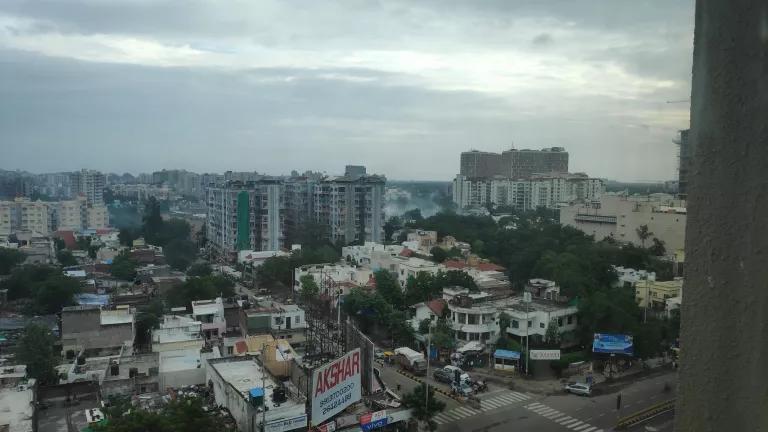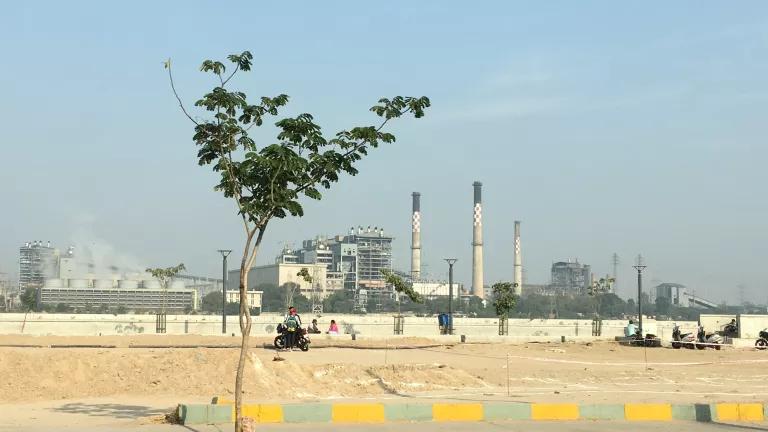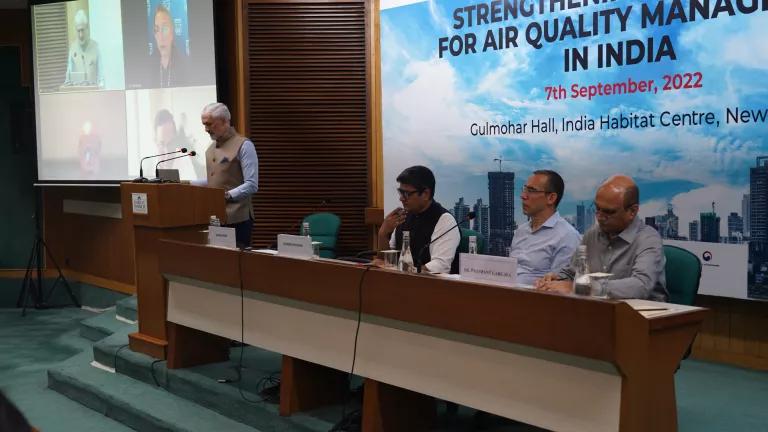Montreal Protocol Virtual Meeting on Ozone Layer and HFCs
Much has changed since the last Meeting of the Parties (MOP) of the Montreal Protocol in November 2019.

Air Conditioning Units in New Delhi
Much has changed since the last Meeting of the Parties (MOP) of the Montreal Protocol in November 2019. The global community is grappling with a new, yet a common challenge, the COVID 19 pandemic and related economic fallout. Amid this challenge, what is clear is that climate change remains a major threat to the long term health of our planet. The action on climate must not stop, is a clear message, if we have to avoid another catastrophe. A manifestation of this message is the continued action on the Montreal Protocol- world’s most successful environment treaty. Delegates from around the world gather alas VIRTUALLY, for the mid-year meeting of the Montreal Protocol this week.
The two issues to watch out for this year’s session (online) of the Open Ended Working Group (OEWG) of the Montreal Protocol are the results of study on replenishment of the Multilateral Fund (MLF) and a discussion on nominations for critical-use exemptions for methyl bromide. Since the parties were expected to adopt a decision in 2020, the online forms have been created to have countries discuss these virtually, the remaining agenda items to be discussed subsequently in 2020 and 2021. Past several months have also witnessed progress on domestic action on HFCs and sustainable cooling in the US, India and China, three countries which are yet to ratify the Kigali Amendment but have been showcasing domestic action.
Multilateral Fund and Energy Efficiency
Every three years, countries agree to fund the Multilateral Fund, the financial arm that implements the Montreal Protocol, in an agreed-upon amount. The Montreal Protocol’s Technology and Economic Assessment Panel (TEAP) established task force has prepared a report on the appropriate level of replenishment of the Fund for the triennium 2021–2023. The estimated total funding requirement is between $377 million and $809 million. The funding requirements are calculated, for a business-as-usual scenario and three additional scenarios based on different levels of ratification of the Kigali Amendment to the Montreal Protocol by Article 5 parties. This however, is not a very good idea. It would perhaps give contributing countries cover to underfund preparations for the HFC phasedown. Countries should provide enough money to support—and actually, encourage—universal participation and a timely start.
It is to be seen this week, how countries would react to these scenarios and the decision that is proposed be finalized at the November 2020 MOP. The good news, is that the study considers the costs of kicking off the Kigali Amendment’s HFC phasedown, which begins in developing countries in 2024. The report also provides an initial estimate of costs for the periods 2024-2026 and 2027-29.
With strong support as part of the Kigali Amendment to include efficiency, countries have been hashing out how the Montreal Protocol should specifically address energy efficiency during the transition away from HFCs. Switching refrigerants presents an opportunity to simultaneously upgrade designs and components to make more energy efficient appliances. Many nations are already moving forward with standards and incentives to improve appliance efficiency through domestic policies, while others are awaiting clarity under the Montreal Protocol.
Countries, have made significant progress in improving efficiency in appliances, particularly with ACs. India’s appliance labelling program has strengthened AC efficiency standards by about 35% since 2006. Just earlier this year, India demonstrated ambition by announcing that all new room ACs will come with a default mandatory setting at 24°C (75°F), encouraging consumers to not over-cool their homes and to save both money and energy on electricity bills while aiming to reduce air pollution. More recently, India announced new energy performance standards for room air conditioners (RACs) on October 30, 2019. Though India has maintained progression in advancing energy efficiency standards periodically, but this revision was markedly lower than the percentage increase proposed in the India Cooling Action Plan (ICAP). This calls for more aggressive action on improving air conditioner efficiency in India, especially the rapidly rising space cooling demand, majority of which is likely to be met by room air conditioners.
China on the other hand, implemented one of the world’s most stringent energy efficiency requirements for room air conditioners this month. New air conditioners and heat pumps (RACs) sold in China will need to be, on average, 15 percent more energy efficient as of July 1st, 2020. While these regulations are applicable to only domestic market, but as Chinese factories update their facilities and supply chains to meet the new Chinese efficiency requirements, there is hope that these improvements will spill over into the models being produced for export. This move is huge and will have enormous carbon intensive electricity savings and reduce country’s climate and air pollution remarkably (read more, here).
Financing energy efficiency improvements through the mechanisms of Montreal Protocol during the HFC phase-down can help unlock the potential for vast reductions in energy use from AC and refrigeration products. In a decision accompanying the Kigali Amendment in 2016, nations agreed to fund HFC phase-down efforts while “maintaining and/or enhancing the energy efficiency” of climate-friendly replacement technologies. The decision indicated the possibility to fund these improvements, at least in part, through the MLF. Therefore, this year’s agenda on amount of replenishment of the MLF, must take into account the costs for financing energy efficiency. Financing EE through a mechanism aligned with the MLF, with help guide investments in EE where needed to ensure that companies are able to improve the efficiencies of their products while switching to climate-friendly refrigerants. NRDC has evaluated mechanisms for implementing energy efficiency while implementing Kigali, and were discussed in several of the past Montreal Protocol Meetings.
Domestic Action on Cooling Continues
With yet another year baking the globe with extreme heat this summer, leading countries continue to work on domestic measures to improve cooling. Though COVID 19 slowed and derailed some of these efforts, but the hope is, as countries get use to the new normal, the steps for sustainable cooling will pick up in the latter half of the year.
US States Act on HFCs
In the US with the lack of clear federal guidance, the action has moved to the states and more and more states are acting to take up HFC legislations. States started taking up HFCs in early 2018, with California leading the way.
A total of 15 states covering 35% of US population have enacted new regulations or are tackling HFCs under existing laws or pending bills. This is extremely encouraging and NRDC has been at the forefront of ensuring the continuity of these actions. The gap in federal regulation created uncertainty in the U.S. market, penalized the companies at the forefront of innovation, and gave up an opportunity for low-cost greenhouse gas emissions reductions across the country. Seeing the high opportunity cost of inaction, states started stepping in under their own pollution control authority. The latest states to act have been the three England states of Massachusetts, Maine and Rhode Island, which announced programs to curb emissions of HFCs earlier in 2020.
Another encouraging headway was made in May 2020, when bipartisan HFC Bill got a socially-distanced senate hearing. Th bipartisan American Innovation and Manufacturing Act (S. 2754) has been placed in Senate to phase down the powerful climate pollutants HFCs. More on this is here.
India Works to Implement the Cooling Action Plan
India released its one of its kind national plan on cooling, the ICAP last year in March 2019. It is one of the first few countries to release such a plan. Sustainable cooling and thermal comfort for all is the thrust area of the ICAP with a focus on synergistic actions than actions taken in isolation. India started to work on implementation of the plan by setting up cross-ministerial multi stakeholder implementation committee since October 2019. NRDC and partners are part of these committees working to develop strategies for implementation. The focus of the committee is the identify and prioritize quick win solutions for implementation by inclusion of such actions in the ongoing programs and activities of the government. NRDC is ramping up action to support the implementation of the ICAP, through scaling up initiatives of cooling load reduction strategies of implementing building energy codes and expanding cool roof programs to protect the vulnerable, also working on pathways for refrigerant transitions.
As the year unfolds with the hope to come out of the pandemic stronger and more resilient, NRDC will continue to work with the global, national and sub-national stakeholders to provide sustainable, climate friendly and socially inclusive cooling to all that reduces vulnerabilities, provides jobs, ensures food security, and health and safety as the country looks for options for economic recovery.




